Business Environment Analysis: Micro, Macro Factors and Stakeholders
VerifiedAdded on 2020/12/31
|10
|3282
|347
Report
AI Summary
This report provides an introduction to the business environment, examining how internal and external factors influence organizational operations and decision-making. It begins by defining the business environment and its impact on organizations, then explores different types of organizations: public, private, and voluntary, detailing their purposes and objectives. The report then focuses on stakeholder mapping, explaining the process of identifying, prioritizing, and understanding key stakeholders, using Burberry as a case study. Finally, it evaluates the micro and macro environments affecting business decisions, including SWOT and PESTEL analyses for Burberry, and Porter's five forces to assess the competitive landscape. The analysis highlights the importance of adapting to changes in the business environment for achieving organizational goals.
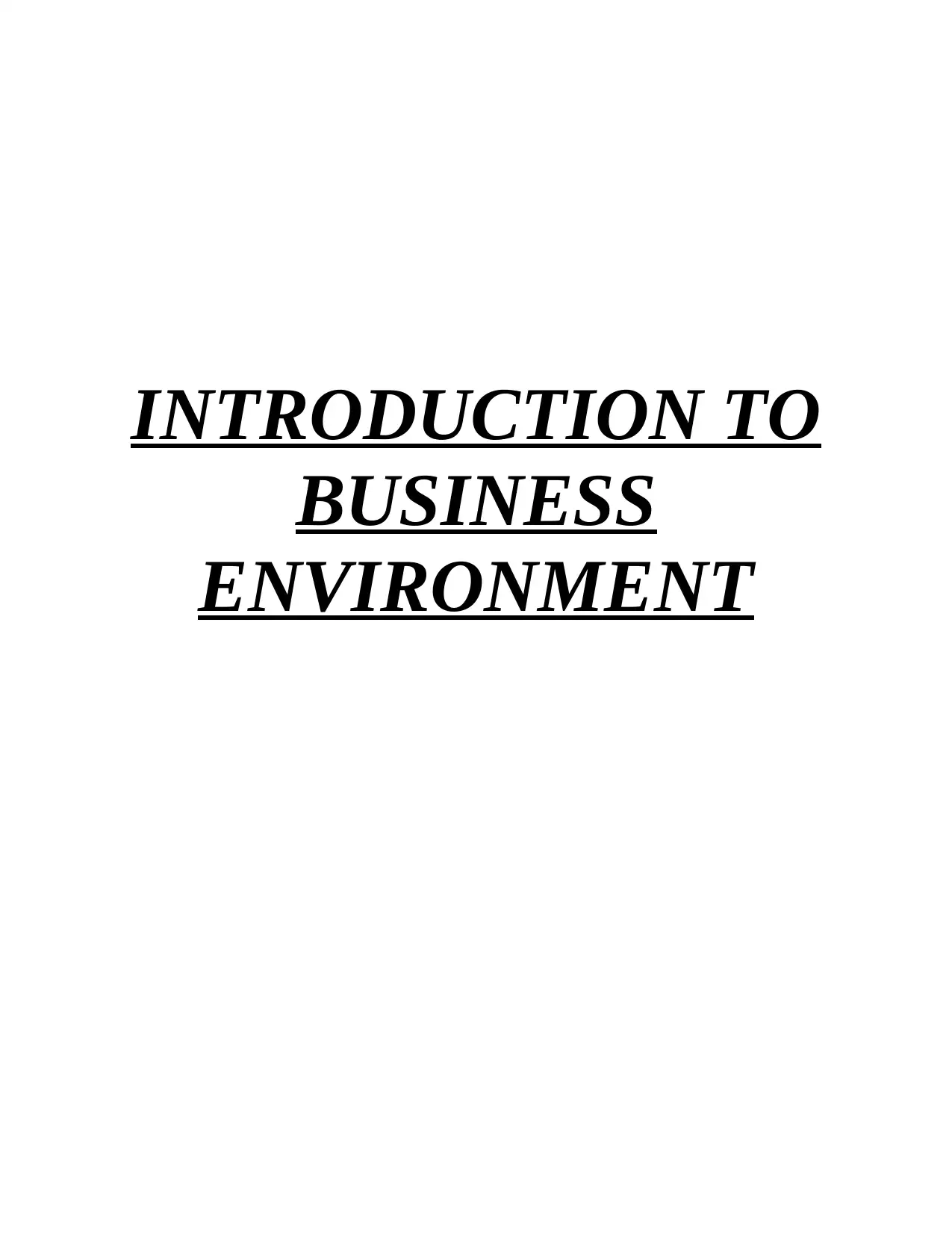
INTRODUCTION TO
BUSINESS
ENVIRONMENT
BUSINESS
ENVIRONMENT
Paraphrase This Document
Need a fresh take? Get an instant paraphrase of this document with our AI Paraphraser

Table of Contents
INTRODUCTION...........................................................................................................................1
TASK 1 ...........................................................................................................................................1
A. Types and purpose of various organisations..........................................................................1
B. The objectives of business groups and shareholder using the stakeholder mapping.............3
C. Evaluating micro and macro environment affecting the decisions of the business...............4
CONCLUSION................................................................................................................................7
REFERENCES................................................................................................................................8
INTRODUCTION...........................................................................................................................1
TASK 1 ...........................................................................................................................................1
A. Types and purpose of various organisations..........................................................................1
B. The objectives of business groups and shareholder using the stakeholder mapping.............3
C. Evaluating micro and macro environment affecting the decisions of the business...............4
CONCLUSION................................................................................................................................7
REFERENCES................................................................................................................................8
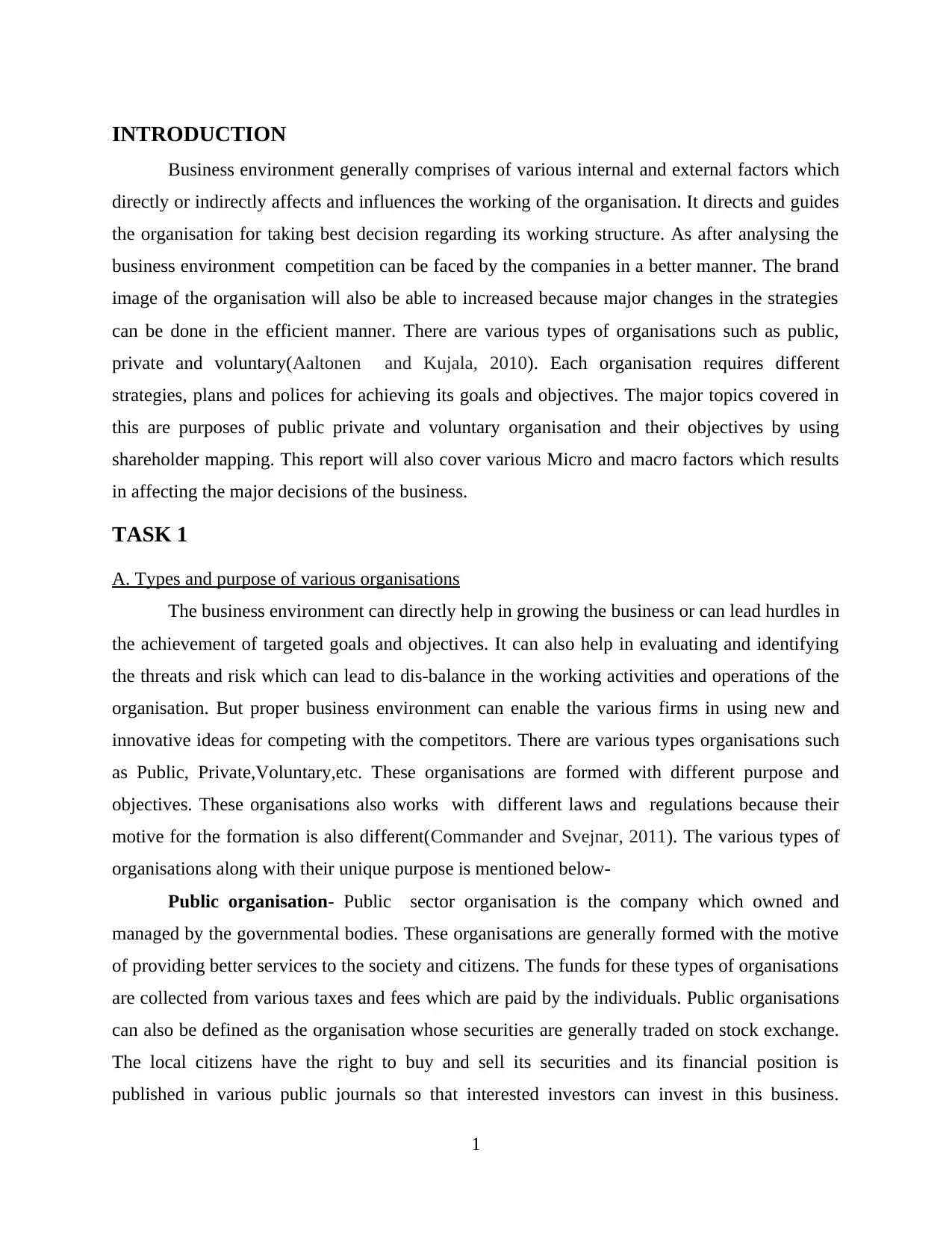
INTRODUCTION
Business environment generally comprises of various internal and external factors which
directly or indirectly affects and influences the working of the organisation. It directs and guides
the organisation for taking best decision regarding its working structure. As after analysing the
business environment competition can be faced by the companies in a better manner. The brand
image of the organisation will also be able to increased because major changes in the strategies
can be done in the efficient manner. There are various types of organisations such as public,
private and voluntary(Aaltonen and Kujala, 2010). Each organisation requires different
strategies, plans and polices for achieving its goals and objectives. The major topics covered in
this are purposes of public private and voluntary organisation and their objectives by using
shareholder mapping. This report will also cover various Micro and macro factors which results
in affecting the major decisions of the business.
TASK 1
A. Types and purpose of various organisations
The business environment can directly help in growing the business or can lead hurdles in
the achievement of targeted goals and objectives. It can also help in evaluating and identifying
the threats and risk which can lead to dis-balance in the working activities and operations of the
organisation. But proper business environment can enable the various firms in using new and
innovative ideas for competing with the competitors. There are various types organisations such
as Public, Private,Voluntary,etc. These organisations are formed with different purpose and
objectives. These organisations also works with different laws and regulations because their
motive for the formation is also different(Commander and Svejnar, 2011). The various types of
organisations along with their unique purpose is mentioned below-
Public organisation- Public sector organisation is the company which owned and
managed by the governmental bodies. These organisations are generally formed with the motive
of providing better services to the society and citizens. The funds for these types of organisations
are collected from various taxes and fees which are paid by the individuals. Public organisations
can also be defined as the organisation whose securities are generally traded on stock exchange.
The local citizens have the right to buy and sell its securities and its financial position is
published in various public journals so that interested investors can invest in this business.
1
Business environment generally comprises of various internal and external factors which
directly or indirectly affects and influences the working of the organisation. It directs and guides
the organisation for taking best decision regarding its working structure. As after analysing the
business environment competition can be faced by the companies in a better manner. The brand
image of the organisation will also be able to increased because major changes in the strategies
can be done in the efficient manner. There are various types of organisations such as public,
private and voluntary(Aaltonen and Kujala, 2010). Each organisation requires different
strategies, plans and polices for achieving its goals and objectives. The major topics covered in
this are purposes of public private and voluntary organisation and their objectives by using
shareholder mapping. This report will also cover various Micro and macro factors which results
in affecting the major decisions of the business.
TASK 1
A. Types and purpose of various organisations
The business environment can directly help in growing the business or can lead hurdles in
the achievement of targeted goals and objectives. It can also help in evaluating and identifying
the threats and risk which can lead to dis-balance in the working activities and operations of the
organisation. But proper business environment can enable the various firms in using new and
innovative ideas for competing with the competitors. There are various types organisations such
as Public, Private,Voluntary,etc. These organisations are formed with different purpose and
objectives. These organisations also works with different laws and regulations because their
motive for the formation is also different(Commander and Svejnar, 2011). The various types of
organisations along with their unique purpose is mentioned below-
Public organisation- Public sector organisation is the company which owned and
managed by the governmental bodies. These organisations are generally formed with the motive
of providing better services to the society and citizens. The funds for these types of organisations
are collected from various taxes and fees which are paid by the individuals. Public organisations
can also be defined as the organisation whose securities are generally traded on stock exchange.
The local citizens have the right to buy and sell its securities and its financial position is
published in various public journals so that interested investors can invest in this business.
1
⊘ This is a preview!⊘
Do you want full access?
Subscribe today to unlock all pages.

Trusted by 1+ million students worldwide
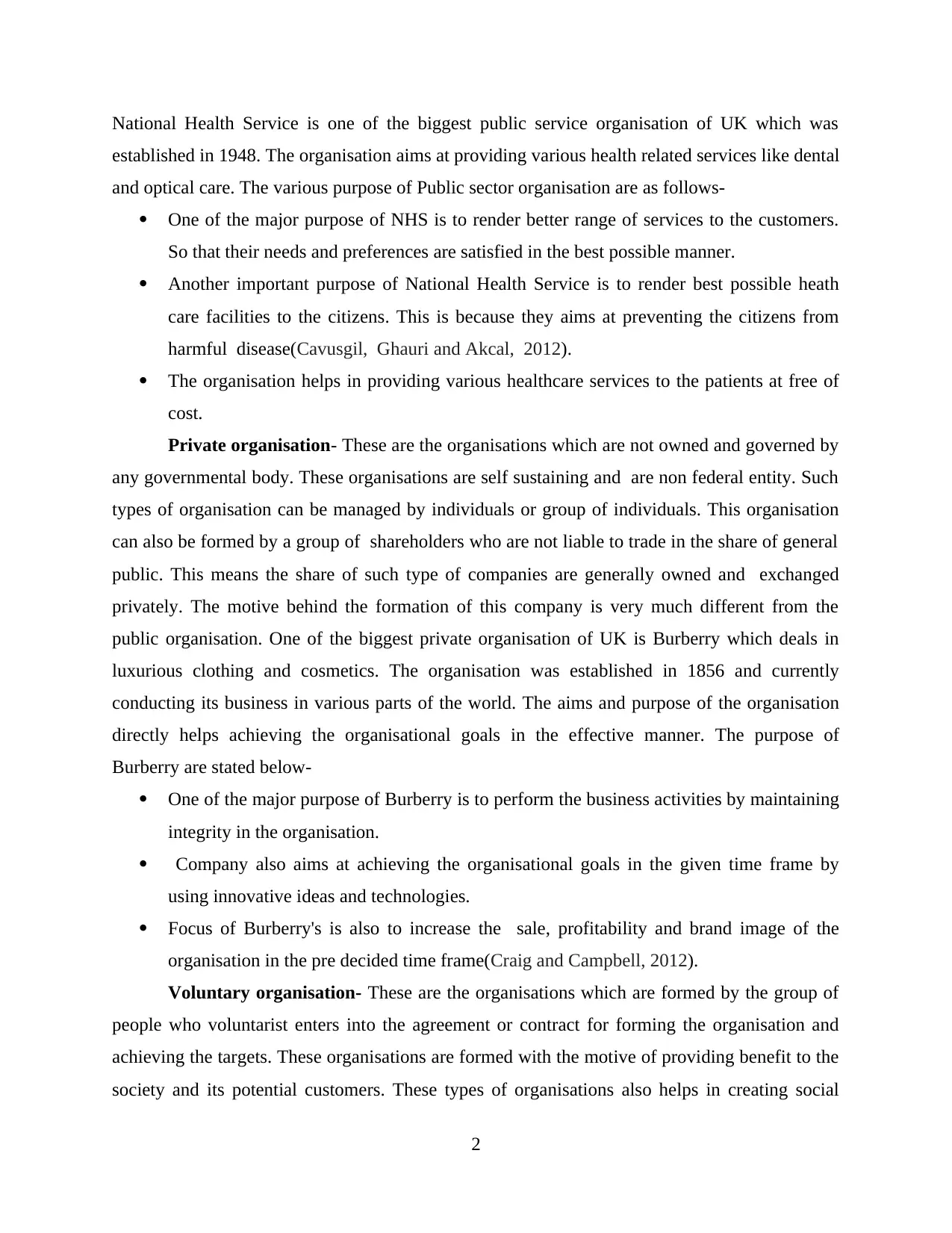
National Health Service is one of the biggest public service organisation of UK which was
established in 1948. The organisation aims at providing various health related services like dental
and optical care. The various purpose of Public sector organisation are as follows-
One of the major purpose of NHS is to render better range of services to the customers.
So that their needs and preferences are satisfied in the best possible manner.
Another important purpose of National Health Service is to render best possible heath
care facilities to the citizens. This is because they aims at preventing the citizens from
harmful disease(Cavusgil, Ghauri and Akcal, 2012).
The organisation helps in providing various healthcare services to the patients at free of
cost.
Private organisation- These are the organisations which are not owned and governed by
any governmental body. These organisations are self sustaining and are non federal entity. Such
types of organisation can be managed by individuals or group of individuals. This organisation
can also be formed by a group of shareholders who are not liable to trade in the share of general
public. This means the share of such type of companies are generally owned and exchanged
privately. The motive behind the formation of this company is very much different from the
public organisation. One of the biggest private organisation of UK is Burberry which deals in
luxurious clothing and cosmetics. The organisation was established in 1856 and currently
conducting its business in various parts of the world. The aims and purpose of the organisation
directly helps achieving the organisational goals in the effective manner. The purpose of
Burberry are stated below-
One of the major purpose of Burberry is to perform the business activities by maintaining
integrity in the organisation.
Company also aims at achieving the organisational goals in the given time frame by
using innovative ideas and technologies.
Focus of Burberry's is also to increase the sale, profitability and brand image of the
organisation in the pre decided time frame(Craig and Campbell, 2012).
Voluntary organisation- These are the organisations which are formed by the group of
people who voluntarist enters into the agreement or contract for forming the organisation and
achieving the targets. These organisations are formed with the motive of providing benefit to the
society and its potential customers. These types of organisations also helps in creating social
2
established in 1948. The organisation aims at providing various health related services like dental
and optical care. The various purpose of Public sector organisation are as follows-
One of the major purpose of NHS is to render better range of services to the customers.
So that their needs and preferences are satisfied in the best possible manner.
Another important purpose of National Health Service is to render best possible heath
care facilities to the citizens. This is because they aims at preventing the citizens from
harmful disease(Cavusgil, Ghauri and Akcal, 2012).
The organisation helps in providing various healthcare services to the patients at free of
cost.
Private organisation- These are the organisations which are not owned and governed by
any governmental body. These organisations are self sustaining and are non federal entity. Such
types of organisation can be managed by individuals or group of individuals. This organisation
can also be formed by a group of shareholders who are not liable to trade in the share of general
public. This means the share of such type of companies are generally owned and exchanged
privately. The motive behind the formation of this company is very much different from the
public organisation. One of the biggest private organisation of UK is Burberry which deals in
luxurious clothing and cosmetics. The organisation was established in 1856 and currently
conducting its business in various parts of the world. The aims and purpose of the organisation
directly helps achieving the organisational goals in the effective manner. The purpose of
Burberry are stated below-
One of the major purpose of Burberry is to perform the business activities by maintaining
integrity in the organisation.
Company also aims at achieving the organisational goals in the given time frame by
using innovative ideas and technologies.
Focus of Burberry's is also to increase the sale, profitability and brand image of the
organisation in the pre decided time frame(Craig and Campbell, 2012).
Voluntary organisation- These are the organisations which are formed by the group of
people who voluntarist enters into the agreement or contract for forming the organisation and
achieving the targets. These organisations are formed with the motive of providing benefit to the
society and its potential customers. These types of organisations also helps in creating social
2
Paraphrase This Document
Need a fresh take? Get an instant paraphrase of this document with our AI Paraphraser
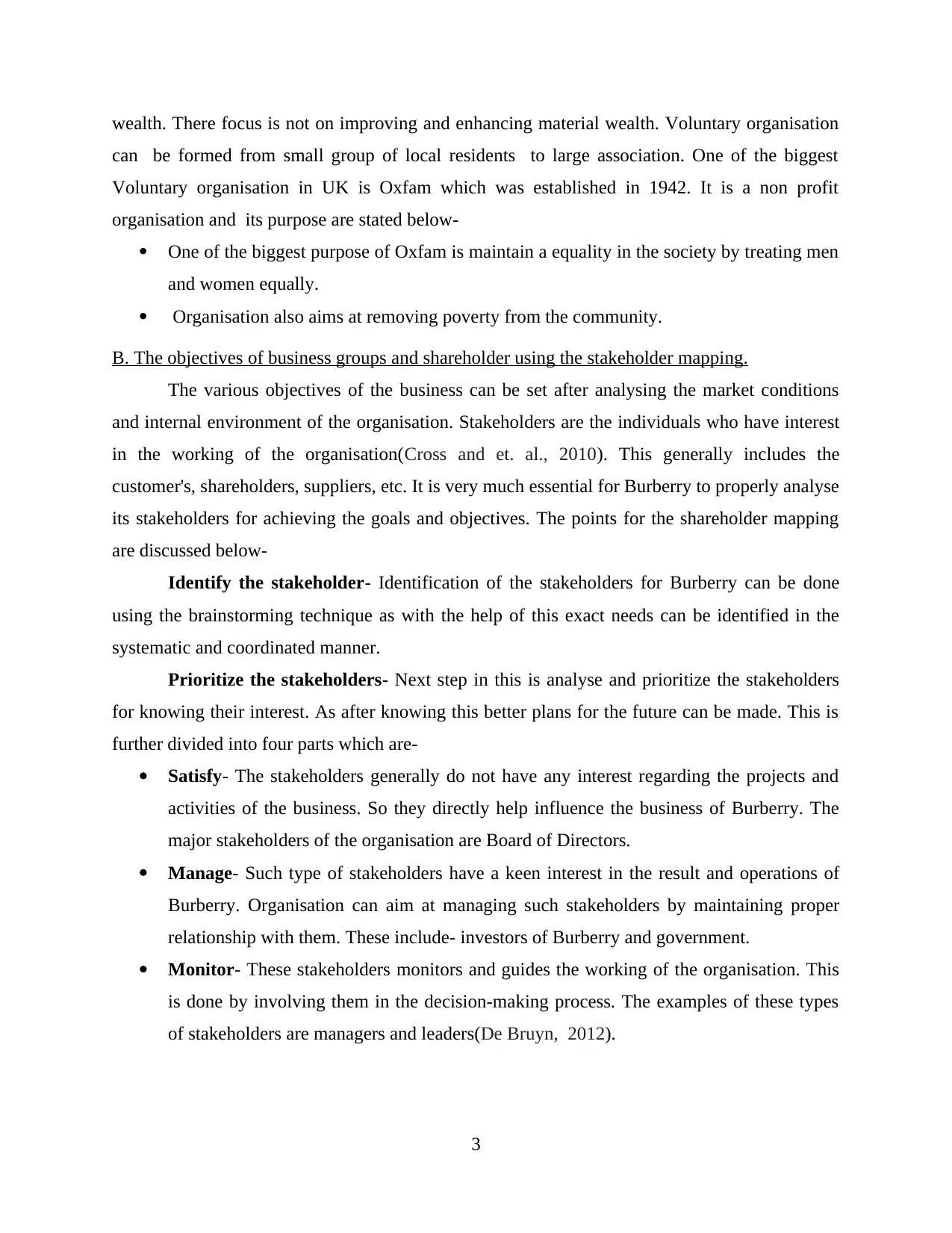
wealth. There focus is not on improving and enhancing material wealth. Voluntary organisation
can be formed from small group of local residents to large association. One of the biggest
Voluntary organisation in UK is Oxfam which was established in 1942. It is a non profit
organisation and its purpose are stated below-
One of the biggest purpose of Oxfam is maintain a equality in the society by treating men
and women equally.
Organisation also aims at removing poverty from the community.
B. The objectives of business groups and shareholder using the stakeholder mapping.
The various objectives of the business can be set after analysing the market conditions
and internal environment of the organisation. Stakeholders are the individuals who have interest
in the working of the organisation(Cross and et. al., 2010). This generally includes the
customer's, shareholders, suppliers, etc. It is very much essential for Burberry to properly analyse
its stakeholders for achieving the goals and objectives. The points for the shareholder mapping
are discussed below-
Identify the stakeholder- Identification of the stakeholders for Burberry can be done
using the brainstorming technique as with the help of this exact needs can be identified in the
systematic and coordinated manner.
Prioritize the stakeholders- Next step in this is analyse and prioritize the stakeholders
for knowing their interest. As after knowing this better plans for the future can be made. This is
further divided into four parts which are-
Satisfy- The stakeholders generally do not have any interest regarding the projects and
activities of the business. So they directly help influence the business of Burberry. The
major stakeholders of the organisation are Board of Directors.
Manage- Such type of stakeholders have a keen interest in the result and operations of
Burberry. Organisation can aim at managing such stakeholders by maintaining proper
relationship with them. These include- investors of Burberry and government.
Monitor- These stakeholders monitors and guides the working of the organisation. This
is done by involving them in the decision-making process. The examples of these types
of stakeholders are managers and leaders(De Bruyn, 2012).
3
can be formed from small group of local residents to large association. One of the biggest
Voluntary organisation in UK is Oxfam which was established in 1942. It is a non profit
organisation and its purpose are stated below-
One of the biggest purpose of Oxfam is maintain a equality in the society by treating men
and women equally.
Organisation also aims at removing poverty from the community.
B. The objectives of business groups and shareholder using the stakeholder mapping.
The various objectives of the business can be set after analysing the market conditions
and internal environment of the organisation. Stakeholders are the individuals who have interest
in the working of the organisation(Cross and et. al., 2010). This generally includes the
customer's, shareholders, suppliers, etc. It is very much essential for Burberry to properly analyse
its stakeholders for achieving the goals and objectives. The points for the shareholder mapping
are discussed below-
Identify the stakeholder- Identification of the stakeholders for Burberry can be done
using the brainstorming technique as with the help of this exact needs can be identified in the
systematic and coordinated manner.
Prioritize the stakeholders- Next step in this is analyse and prioritize the stakeholders
for knowing their interest. As after knowing this better plans for the future can be made. This is
further divided into four parts which are-
Satisfy- The stakeholders generally do not have any interest regarding the projects and
activities of the business. So they directly help influence the business of Burberry. The
major stakeholders of the organisation are Board of Directors.
Manage- Such type of stakeholders have a keen interest in the result and operations of
Burberry. Organisation can aim at managing such stakeholders by maintaining proper
relationship with them. These include- investors of Burberry and government.
Monitor- These stakeholders monitors and guides the working of the organisation. This
is done by involving them in the decision-making process. The examples of these types
of stakeholders are managers and leaders(De Bruyn, 2012).
3
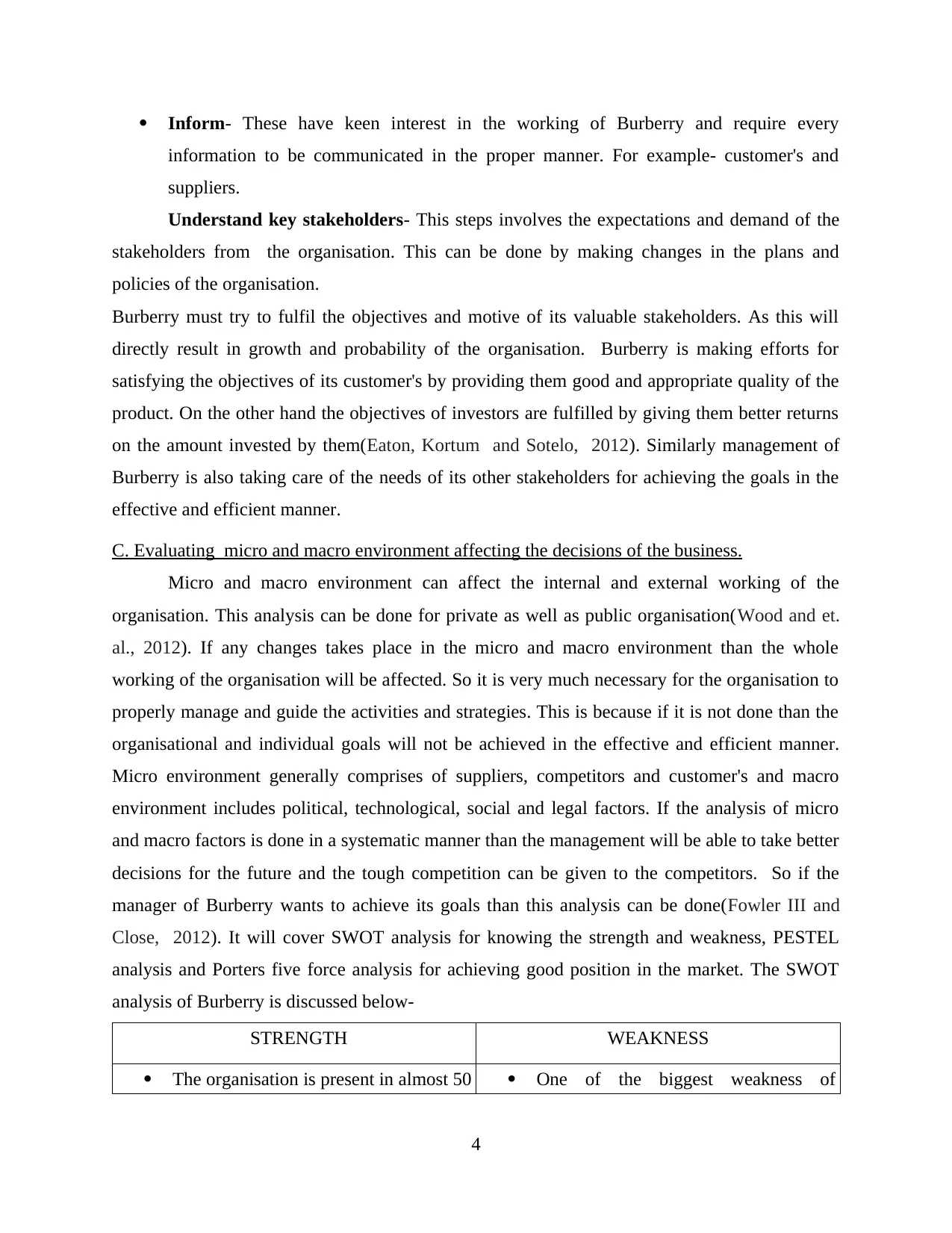
Inform- These have keen interest in the working of Burberry and require every
information to be communicated in the proper manner. For example- customer's and
suppliers.
Understand key stakeholders- This steps involves the expectations and demand of the
stakeholders from the organisation. This can be done by making changes in the plans and
policies of the organisation.
Burberry must try to fulfil the objectives and motive of its valuable stakeholders. As this will
directly result in growth and probability of the organisation. Burberry is making efforts for
satisfying the objectives of its customer's by providing them good and appropriate quality of the
product. On the other hand the objectives of investors are fulfilled by giving them better returns
on the amount invested by them(Eaton, Kortum and Sotelo, 2012). Similarly management of
Burberry is also taking care of the needs of its other stakeholders for achieving the goals in the
effective and efficient manner.
C. Evaluating micro and macro environment affecting the decisions of the business.
Micro and macro environment can affect the internal and external working of the
organisation. This analysis can be done for private as well as public organisation(Wood and et.
al., 2012). If any changes takes place in the micro and macro environment than the whole
working of the organisation will be affected. So it is very much necessary for the organisation to
properly manage and guide the activities and strategies. This is because if it is not done than the
organisational and individual goals will not be achieved in the effective and efficient manner.
Micro environment generally comprises of suppliers, competitors and customer's and macro
environment includes political, technological, social and legal factors. If the analysis of micro
and macro factors is done in a systematic manner than the management will be able to take better
decisions for the future and the tough competition can be given to the competitors. So if the
manager of Burberry wants to achieve its goals than this analysis can be done(Fowler III and
Close, 2012). It will cover SWOT analysis for knowing the strength and weakness, PESTEL
analysis and Porters five force analysis for achieving good position in the market. The SWOT
analysis of Burberry is discussed below-
STRENGTH WEAKNESS
The organisation is present in almost 50 One of the biggest weakness of
4
information to be communicated in the proper manner. For example- customer's and
suppliers.
Understand key stakeholders- This steps involves the expectations and demand of the
stakeholders from the organisation. This can be done by making changes in the plans and
policies of the organisation.
Burberry must try to fulfil the objectives and motive of its valuable stakeholders. As this will
directly result in growth and probability of the organisation. Burberry is making efforts for
satisfying the objectives of its customer's by providing them good and appropriate quality of the
product. On the other hand the objectives of investors are fulfilled by giving them better returns
on the amount invested by them(Eaton, Kortum and Sotelo, 2012). Similarly management of
Burberry is also taking care of the needs of its other stakeholders for achieving the goals in the
effective and efficient manner.
C. Evaluating micro and macro environment affecting the decisions of the business.
Micro and macro environment can affect the internal and external working of the
organisation. This analysis can be done for private as well as public organisation(Wood and et.
al., 2012). If any changes takes place in the micro and macro environment than the whole
working of the organisation will be affected. So it is very much necessary for the organisation to
properly manage and guide the activities and strategies. This is because if it is not done than the
organisational and individual goals will not be achieved in the effective and efficient manner.
Micro environment generally comprises of suppliers, competitors and customer's and macro
environment includes political, technological, social and legal factors. If the analysis of micro
and macro factors is done in a systematic manner than the management will be able to take better
decisions for the future and the tough competition can be given to the competitors. So if the
manager of Burberry wants to achieve its goals than this analysis can be done(Fowler III and
Close, 2012). It will cover SWOT analysis for knowing the strength and weakness, PESTEL
analysis and Porters five force analysis for achieving good position in the market. The SWOT
analysis of Burberry is discussed below-
STRENGTH WEAKNESS
The organisation is present in almost 50 One of the biggest weakness of
4
⊘ This is a preview!⊘
Do you want full access?
Subscribe today to unlock all pages.

Trusted by 1+ million students worldwide
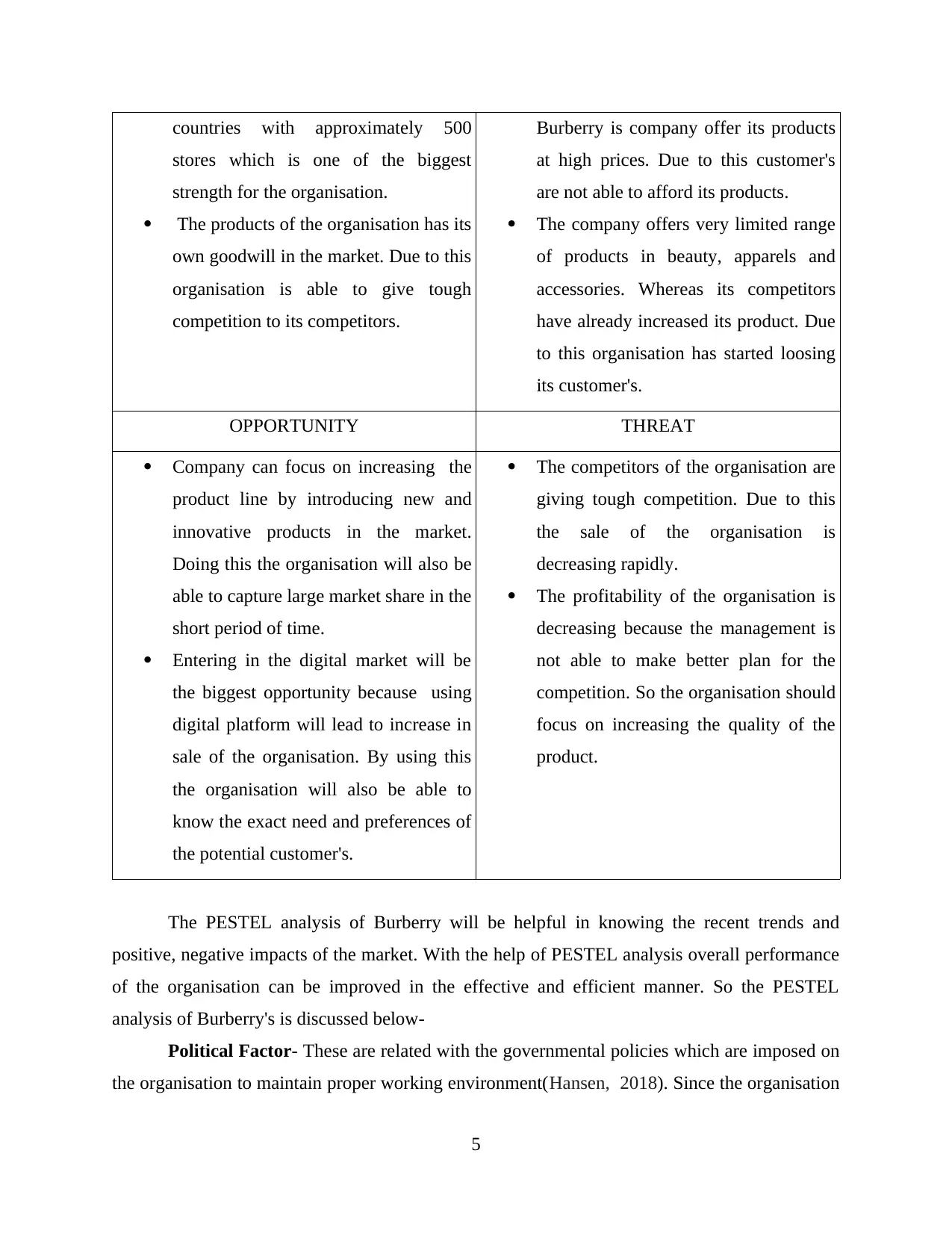
countries with approximately 500
stores which is one of the biggest
strength for the organisation.
The products of the organisation has its
own goodwill in the market. Due to this
organisation is able to give tough
competition to its competitors.
Burberry is company offer its products
at high prices. Due to this customer's
are not able to afford its products.
The company offers very limited range
of products in beauty, apparels and
accessories. Whereas its competitors
have already increased its product. Due
to this organisation has started loosing
its customer's.
OPPORTUNITY THREAT
Company can focus on increasing the
product line by introducing new and
innovative products in the market.
Doing this the organisation will also be
able to capture large market share in the
short period of time.
Entering in the digital market will be
the biggest opportunity because using
digital platform will lead to increase in
sale of the organisation. By using this
the organisation will also be able to
know the exact need and preferences of
the potential customer's.
The competitors of the organisation are
giving tough competition. Due to this
the sale of the organisation is
decreasing rapidly.
The profitability of the organisation is
decreasing because the management is
not able to make better plan for the
competition. So the organisation should
focus on increasing the quality of the
product.
The PESTEL analysis of Burberry will be helpful in knowing the recent trends and
positive, negative impacts of the market. With the help of PESTEL analysis overall performance
of the organisation can be improved in the effective and efficient manner. So the PESTEL
analysis of Burberry's is discussed below-
Political Factor- These are related with the governmental policies which are imposed on
the organisation to maintain proper working environment(Hansen, 2018). Since the organisation
5
stores which is one of the biggest
strength for the organisation.
The products of the organisation has its
own goodwill in the market. Due to this
organisation is able to give tough
competition to its competitors.
Burberry is company offer its products
at high prices. Due to this customer's
are not able to afford its products.
The company offers very limited range
of products in beauty, apparels and
accessories. Whereas its competitors
have already increased its product. Due
to this organisation has started loosing
its customer's.
OPPORTUNITY THREAT
Company can focus on increasing the
product line by introducing new and
innovative products in the market.
Doing this the organisation will also be
able to capture large market share in the
short period of time.
Entering in the digital market will be
the biggest opportunity because using
digital platform will lead to increase in
sale of the organisation. By using this
the organisation will also be able to
know the exact need and preferences of
the potential customer's.
The competitors of the organisation are
giving tough competition. Due to this
the sale of the organisation is
decreasing rapidly.
The profitability of the organisation is
decreasing because the management is
not able to make better plan for the
competition. So the organisation should
focus on increasing the quality of the
product.
The PESTEL analysis of Burberry will be helpful in knowing the recent trends and
positive, negative impacts of the market. With the help of PESTEL analysis overall performance
of the organisation can be improved in the effective and efficient manner. So the PESTEL
analysis of Burberry's is discussed below-
Political Factor- These are related with the governmental policies which are imposed on
the organisation to maintain proper working environment(Hansen, 2018). Since the organisation
5
Paraphrase This Document
Need a fresh take? Get an instant paraphrase of this document with our AI Paraphraser

operates in various parts of the world. So the management of the organisation has to deal with
various laws and regulations of different countries. Due to this it becomes difficult for the
organisation to manage each and every activity in a proper manner. This factors have a positive
and negative impact on the working of the organisation(Stokes, Wilson and Wilson, 2010). The
positive impact is if the liberalisation policy of one country is flexible than firm can easily
achieve its targeted goals. Whereas on the other hand negative impact is in some countries there
is high tax is being charged on the products so it is creating a unfavourable conditions for the
organisation.
Economic factor- This factor directly affects the purchasing power of the buyers because
of the increase or decrease of the inflation rate. This factor also leaves a positive and negative
impact on the working of the organisation. So the positive impact of economic factor is the brand
image of the organisation is increased because company offers high and prestigious quality of
products. The negative impact is company faces high competition in the market because of the
local retailers which offer products at low price.
Social factor- It is concerned with values and belief of the society in which company
operates its business. Social factor helps in collecting proper information regarding the needs and
demand of the people by not hurting their values and beliefs which is a positive point for
Burberry. Whereas the negative point is Burberry is unable in considering the values and beliefs
of every country in which it operates(Johnson and et. al., 2011).
Technological factor- These include the use of latest technology and ideas for
conducting the business activities. Burberry uses latest techniques for manufacturing its products
and due to this company is able to use the resources in the best possible manner. Burberry has
introduced online payment techniques for its customer's which was necessary because the
customer's were demanding it.
Environmental factor- These are the weather and other environmental aspects which
can result in affecting the business of Burberry. Organisation is continuously making efforts for
controlling the environmental factor. As Burberry is using eco friendly materials for
manufacturing its products. This is resulting in saving and conserving the environment.
Legal factor- These are the laws and regulations which needs to be kept in mind by the
organisation for achieving the goals. The management of Burberry conducts analysis regarding
6
various laws and regulations of different countries. Due to this it becomes difficult for the
organisation to manage each and every activity in a proper manner. This factors have a positive
and negative impact on the working of the organisation(Stokes, Wilson and Wilson, 2010). The
positive impact is if the liberalisation policy of one country is flexible than firm can easily
achieve its targeted goals. Whereas on the other hand negative impact is in some countries there
is high tax is being charged on the products so it is creating a unfavourable conditions for the
organisation.
Economic factor- This factor directly affects the purchasing power of the buyers because
of the increase or decrease of the inflation rate. This factor also leaves a positive and negative
impact on the working of the organisation. So the positive impact of economic factor is the brand
image of the organisation is increased because company offers high and prestigious quality of
products. The negative impact is company faces high competition in the market because of the
local retailers which offer products at low price.
Social factor- It is concerned with values and belief of the society in which company
operates its business. Social factor helps in collecting proper information regarding the needs and
demand of the people by not hurting their values and beliefs which is a positive point for
Burberry. Whereas the negative point is Burberry is unable in considering the values and beliefs
of every country in which it operates(Johnson and et. al., 2011).
Technological factor- These include the use of latest technology and ideas for
conducting the business activities. Burberry uses latest techniques for manufacturing its products
and due to this company is able to use the resources in the best possible manner. Burberry has
introduced online payment techniques for its customer's which was necessary because the
customer's were demanding it.
Environmental factor- These are the weather and other environmental aspects which
can result in affecting the business of Burberry. Organisation is continuously making efforts for
controlling the environmental factor. As Burberry is using eco friendly materials for
manufacturing its products. This is resulting in saving and conserving the environment.
Legal factor- These are the laws and regulations which needs to be kept in mind by the
organisation for achieving the goals. The management of Burberry conducts analysis regarding
6
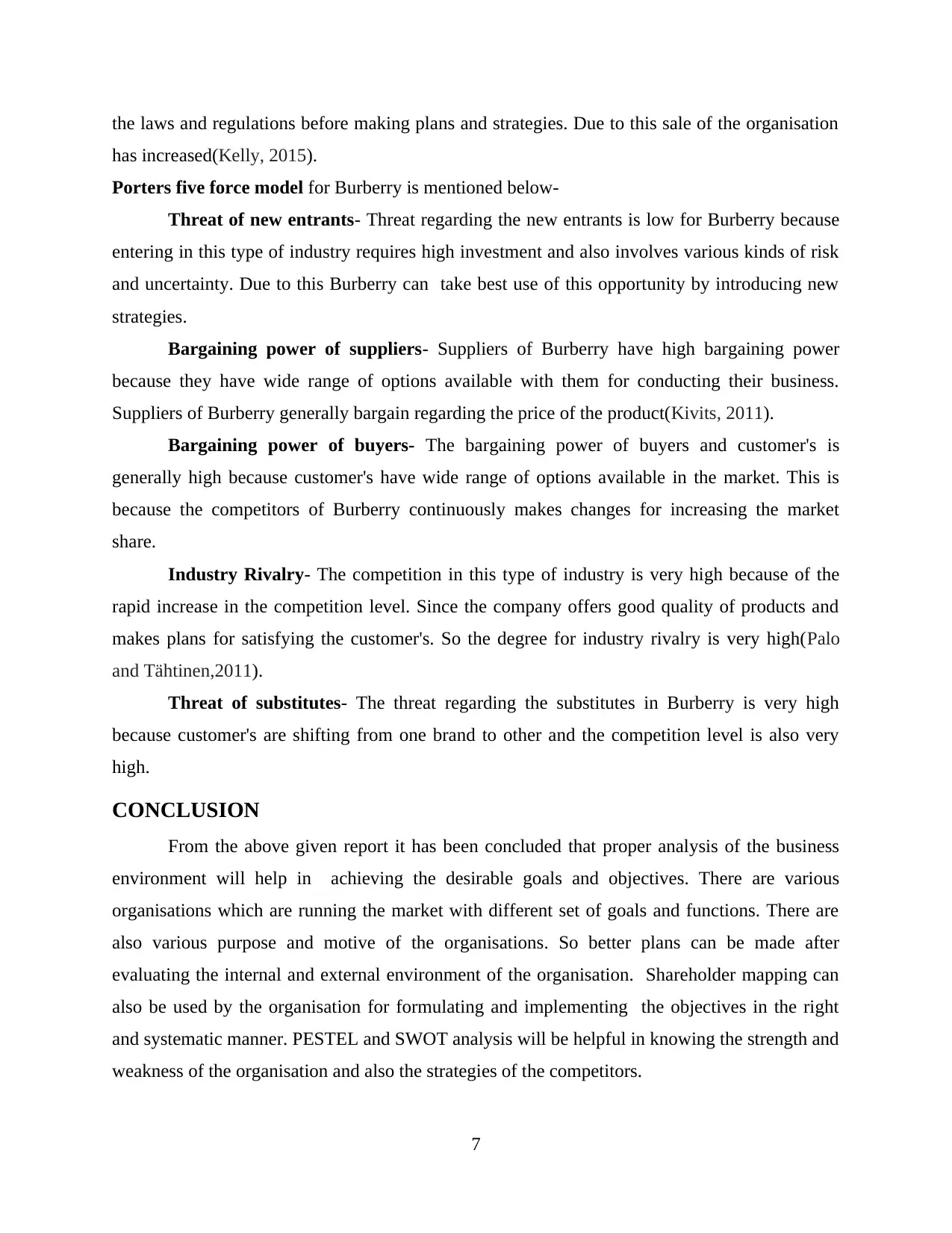
the laws and regulations before making plans and strategies. Due to this sale of the organisation
has increased(Kelly, 2015).
Porters five force model for Burberry is mentioned below-
Threat of new entrants- Threat regarding the new entrants is low for Burberry because
entering in this type of industry requires high investment and also involves various kinds of risk
and uncertainty. Due to this Burberry can take best use of this opportunity by introducing new
strategies.
Bargaining power of suppliers- Suppliers of Burberry have high bargaining power
because they have wide range of options available with them for conducting their business.
Suppliers of Burberry generally bargain regarding the price of the product(Kivits, 2011).
Bargaining power of buyers- The bargaining power of buyers and customer's is
generally high because customer's have wide range of options available in the market. This is
because the competitors of Burberry continuously makes changes for increasing the market
share.
Industry Rivalry- The competition in this type of industry is very high because of the
rapid increase in the competition level. Since the company offers good quality of products and
makes plans for satisfying the customer's. So the degree for industry rivalry is very high(Palo
and Tähtinen,2011).
Threat of substitutes- The threat regarding the substitutes in Burberry is very high
because customer's are shifting from one brand to other and the competition level is also very
high.
CONCLUSION
From the above given report it has been concluded that proper analysis of the business
environment will help in achieving the desirable goals and objectives. There are various
organisations which are running the market with different set of goals and functions. There are
also various purpose and motive of the organisations. So better plans can be made after
evaluating the internal and external environment of the organisation. Shareholder mapping can
also be used by the organisation for formulating and implementing the objectives in the right
and systematic manner. PESTEL and SWOT analysis will be helpful in knowing the strength and
weakness of the organisation and also the strategies of the competitors.
7
has increased(Kelly, 2015).
Porters five force model for Burberry is mentioned below-
Threat of new entrants- Threat regarding the new entrants is low for Burberry because
entering in this type of industry requires high investment and also involves various kinds of risk
and uncertainty. Due to this Burberry can take best use of this opportunity by introducing new
strategies.
Bargaining power of suppliers- Suppliers of Burberry have high bargaining power
because they have wide range of options available with them for conducting their business.
Suppliers of Burberry generally bargain regarding the price of the product(Kivits, 2011).
Bargaining power of buyers- The bargaining power of buyers and customer's is
generally high because customer's have wide range of options available in the market. This is
because the competitors of Burberry continuously makes changes for increasing the market
share.
Industry Rivalry- The competition in this type of industry is very high because of the
rapid increase in the competition level. Since the company offers good quality of products and
makes plans for satisfying the customer's. So the degree for industry rivalry is very high(Palo
and Tähtinen,2011).
Threat of substitutes- The threat regarding the substitutes in Burberry is very high
because customer's are shifting from one brand to other and the competition level is also very
high.
CONCLUSION
From the above given report it has been concluded that proper analysis of the business
environment will help in achieving the desirable goals and objectives. There are various
organisations which are running the market with different set of goals and functions. There are
also various purpose and motive of the organisations. So better plans can be made after
evaluating the internal and external environment of the organisation. Shareholder mapping can
also be used by the organisation for formulating and implementing the objectives in the right
and systematic manner. PESTEL and SWOT analysis will be helpful in knowing the strength and
weakness of the organisation and also the strategies of the competitors.
7
⊘ This is a preview!⊘
Do you want full access?
Subscribe today to unlock all pages.

Trusted by 1+ million students worldwide

REFERENCES
Books and journals
Aaltonen, K. and Kujala, J., 2010. A project lifecycle perspective on stakeholder influence
strategies in global projects. Scandinavian journal of management. 26(4). pp.381-397.
Cavusgil, S.T., Ghauri, P.N. and Akcal, A.A., 2012. Doing business in emerging markets. Sage.
Commander, S. and Svejnar, J., 2011. Business environment, exports, ownership, and firm
performance. The Review of Economics and Statistics. 93(1). pp.309-337.
Craig, T. and Campbell, D., 2012. Organisations and the business environment. Routledge.
Cross, R.L., and et. al., 2010. The organizational network fieldbook: Best practices, techniques
and exercises to drive organizational innovation and performance. John Wiley & Sons.
De Bruyn, S.M., 2012. Economic growth and the environment: An empirical analysis (Vol. 18).
Springer Science & Business Media.
Eaton, J., Kortum, S.S. and Sotelo, S., 2012. International trade: Linking micro and macro (No.
w17864). National bureau of economic research.
Fowler III, A.R. and Close, A.G., 2012. It ain't easy being green: Macro, meso, and micro green
advertising agendas. Journal of Advertising. 41(4). pp.119-132.
Hansen, A., 2018. Environment, media and communication. Routledge.
Johnson, G., and et. al., 2011. Exploring strategy. Financial Times Prentice Hall.
Kelly, M., 2015. Finding meaning in the business environment. Philosophy of Management.
14(2). pp.135-156.
Kivits, R.A., 2011. Three component stakeholder analysis. International Journal of Multiple
Research Approaches. 5(3). pp.318-333.
Palo, T. and Tähtinen, J., 2011. A network perspective on business models for emerging
technology-based services. Journal of Business & Industrial Marketing. 26(5). pp.377-
388.
Stokes, D., Wilson, N. and Wilson, N., 2010. Small business management and entrepreneurship.
Cengage Learning EMEA.
Wood, M.D., and et. al., 2012. Cognitive mapping tools: review and risk management needs.
Risk Analysis: An International Journal. 32(8). pp.1333-1348.
8
Books and journals
Aaltonen, K. and Kujala, J., 2010. A project lifecycle perspective on stakeholder influence
strategies in global projects. Scandinavian journal of management. 26(4). pp.381-397.
Cavusgil, S.T., Ghauri, P.N. and Akcal, A.A., 2012. Doing business in emerging markets. Sage.
Commander, S. and Svejnar, J., 2011. Business environment, exports, ownership, and firm
performance. The Review of Economics and Statistics. 93(1). pp.309-337.
Craig, T. and Campbell, D., 2012. Organisations and the business environment. Routledge.
Cross, R.L., and et. al., 2010. The organizational network fieldbook: Best practices, techniques
and exercises to drive organizational innovation and performance. John Wiley & Sons.
De Bruyn, S.M., 2012. Economic growth and the environment: An empirical analysis (Vol. 18).
Springer Science & Business Media.
Eaton, J., Kortum, S.S. and Sotelo, S., 2012. International trade: Linking micro and macro (No.
w17864). National bureau of economic research.
Fowler III, A.R. and Close, A.G., 2012. It ain't easy being green: Macro, meso, and micro green
advertising agendas. Journal of Advertising. 41(4). pp.119-132.
Hansen, A., 2018. Environment, media and communication. Routledge.
Johnson, G., and et. al., 2011. Exploring strategy. Financial Times Prentice Hall.
Kelly, M., 2015. Finding meaning in the business environment. Philosophy of Management.
14(2). pp.135-156.
Kivits, R.A., 2011. Three component stakeholder analysis. International Journal of Multiple
Research Approaches. 5(3). pp.318-333.
Palo, T. and Tähtinen, J., 2011. A network perspective on business models for emerging
technology-based services. Journal of Business & Industrial Marketing. 26(5). pp.377-
388.
Stokes, D., Wilson, N. and Wilson, N., 2010. Small business management and entrepreneurship.
Cengage Learning EMEA.
Wood, M.D., and et. al., 2012. Cognitive mapping tools: review and risk management needs.
Risk Analysis: An International Journal. 32(8). pp.1333-1348.
8
1 out of 10